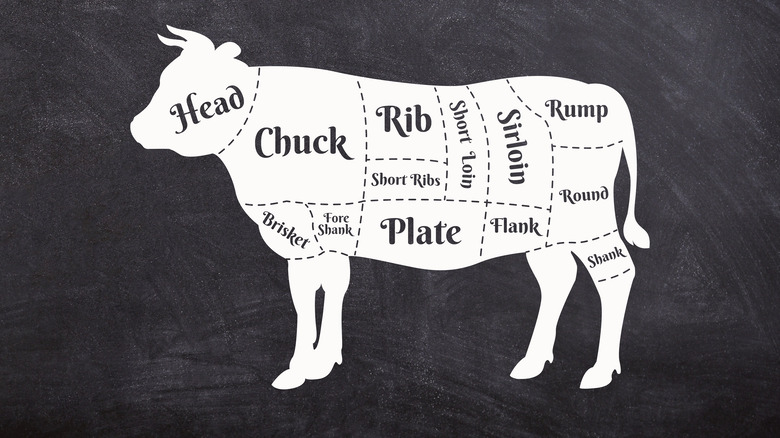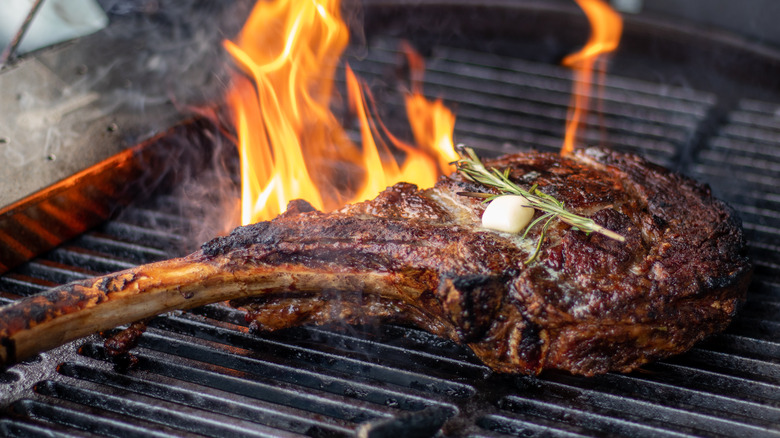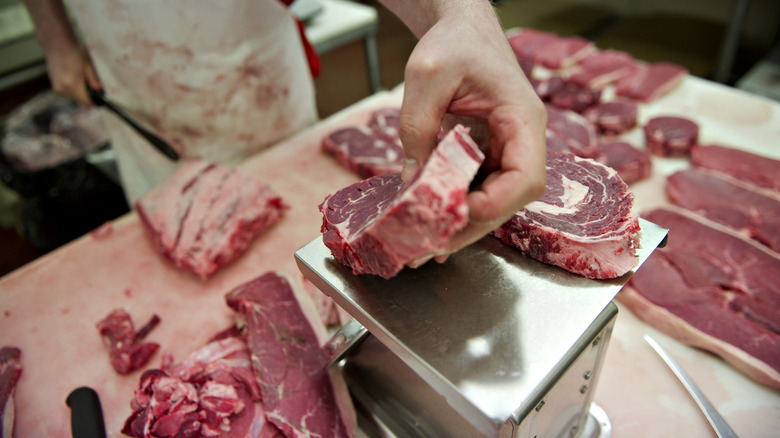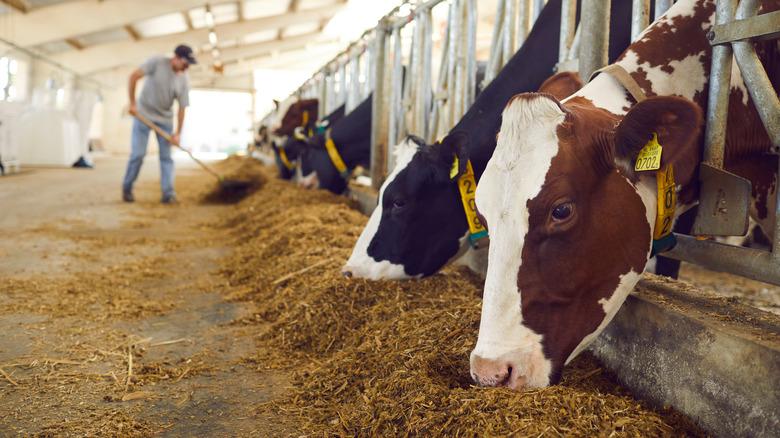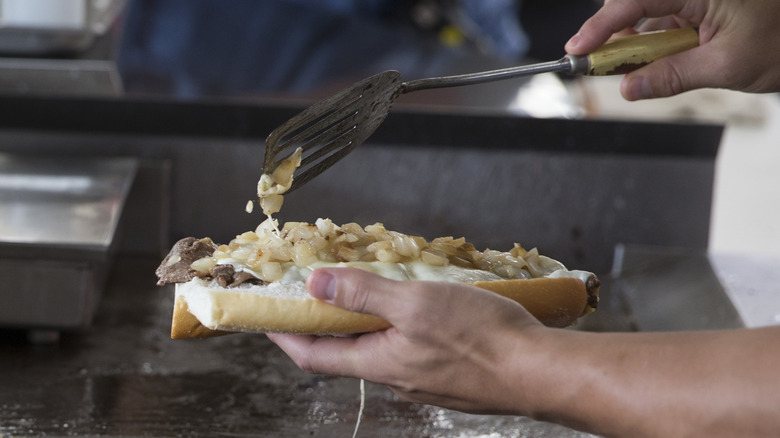Everything You Should Know About Ribeye Steak
The word "ribeye" has the capacity to induce a Pavlovian response in true steak obsessives, sending salivary glands into overdrive in anticipation of a juicy, beefy, oh-so-tender hunk of premium beef. It commands a hefty price at steakhouses, but aficionados know it's worth it: When a ribeye is prepared well, it's mind-meltingly good. Many of us know that ribeye is a great thing to order if you see it on a restaurant menu, but why is that? What makes ribeye one of the most desirable pieces of beef you can buy? We're here to answer that question.
If you've ever wondered where exactly ribeyes come from, read on. You'll also learn some fun facts about the history of this illustrious cut. Even more importantly, if you want to move past simply ordering ribeyes from restaurants, we'll tell you all you need to know about buying and preparing the perfect ribeye steak at home. Armed with the wisdom from this article, you'll become a true meat master.
Ribeye is a cut from the rib primal
As the name would suggest, ribeye steaks are cut from the rib section of a steer. Omaha Steaks notes that this section of the animal is right behind the shoulder, or chuck. Specifically, ribeyes are cut from the meat that lies between the 6th and 12th rib of the steer.
Ribeyes are prized for their tender texture, beefy taste, and high level of intramuscular fat (marbling). The rib primal is particularly well-suited for cutting into steaks because it's fattier than many other areas of the animal. You might not think you like fatty meat, but the fat in a ribeye is key to this cut's buttery taste and melt-in-your-mouth texture. The fat moistens and bastes the meat during cooking, giving you crave-worthy end results.
But ribeyes aren't just fatty in all the right ways — the meat is also naturally tender. This is because, per How Stuff Works, the ribcage muscles that make up a ribeye don't get much exercise while the cow is alive. Since these muscles don't do much work, they end up being very tender. This combination of tenderness and delicious fat can't be equaled by many other steaks (if any), so there's a good reason why you have to shell out top dollar for a good ribeye.
Ribeye steak is similar to prime rib
Prime rib is another cut from the rib primal. In fact, it's basically the same piece of meat as a ribeye, except it's left as one large roast instead of being sliced into steaks (via Steak University). The size is the main difference between prime rib and ribeye. Confusingly, the word "prime" in prime rib does not mean it must be USDA Prime-grade meat. Prime rib is really just a colloquial term for a standing rib roast of any grade.
Although both cuts consist of the same meat, their different form factors mean they're usually treated differently. Prime rib is great when it's slow-roasted, while ribeyes can generally be cooked hot and fast like a porterhouse or New York strip.
If you want to serve ribeye steaks to a crowd and aren't afraid of doing your own butchering, you can save a few bucks by buying a whole standing rib roast and cutting it into ribeye steaks yourself. The Bearded Butchers have a tutorial on how to do this if you feel confident in your slicing skills. In addition to the monetary savings, cutting your own steaks has other advantages: You can choose how much fat to rim off, how thick to cut your steaks, and whether you want bone-in or boneless ribeyes.
A ribeye is composed of up to three different muscles
Although it's sold as one piece of meat, a ribeye isn't just a slice of one muscle like a filet mignon (which comes from the tenderloin muscle). Instead, ribeyes are two (or sometimes even three) muscles stuck together, according to Omaha Steaks.
The bulk of a ribeye steak is the longissimus dorsi muscle. It is the "eye" in ribeye's name. This is the meaty, marbled muscle in the middle of the steak. It's flanked on either side by large chunks of fat that separate it from the other two muscles. At one end of the steak, the ribeye cap (the spinalis muscle) curves around the eye. This is the most tender part of the steak, and it also has a coarsely-grained texture that's somewhat reminiscent of skirt steak, per Complete Carnivore. Some butchers actually sell the spinalis by itself, but it's even more expensive than a full ribeye.
At the opposite end of the steak from the cap is a muscle called the complexus. Not all ribeyes have a piece of this muscle; it depends on how the steaks were butchered and what part of the rib primal they were cut from.
Delmonico's perfected the ribeye (maybe)
You might find some sources selling ribeyes as Delmonico steaks. The term refers to Delmonico's, a New York City fine dining institution that may have been the first modern restaurant (that is, a restaurant with a menu that customers could choose from à la carte) in the U.S. (via Britannica). According to Grassland Meats, Delmonico's cooked a variety of cuts of steak — what makes a Delmonico steak is the preparation, not the specific piece of meat. Delmonico steaks should be wet-aged and thick-cut (often in excess of two inches thick). The steaks are then rubbed with fat, broiled, and served with herb butter.
In contrast to Grassland Meats, Joe O'Connell at Steak Perfection argues that the Delmonico was originally a specific cut of steak. He acknowledges that many experts, including Martha Stewart and Julia Child, say that ribeyes are Delmonico steaks, but he claims this is false. He cites two 19th-century recipes from chefs who worked at the restaurant, both of which say the meat used is sirloin. The modern sirloin cut is nowhere near the rib primal, but back in the 1800s, "sirloin" referred to the meat from a cow's top loin muscles, which would include the ribeye, as well as other cuts like New York Strip. By analyzing an illustration one of the Delmonico's chefs made of the restaurant's famous steaks, O'Connell concludes that the original Delmonico steak was a boneless top loin with no eye (in other words, not a ribeye).
Bone-in vs. boneless ribeye
You can buy ribeyes either boneless or with a piece of the rib bone still attached. Which one is better is the subject of fierce debate. There are many myths associated with bone-in steaks. Bone partisans argue that bones are filled with flavorful marrow that seasons the steak during cooking (via Steak School by Stanbroke). There is also a layer of connective tissue holding the bone to the meat that could, in theory, melt and baste the meat, per ThermoBlog. Sadly, the high-heat, brief cooking methods you're likely to use when preparing a ribeye are ill-suited to extracting flavor from bones, marrow, and connective tissue. For that, you need low, slow, long cooking in liquid — braising is perfect for this purpose.
That's not to say that bones do nothing to help out a steak. Their mass and porous structure insulate the meat they're attached to, protecting it from the heat. This helps the steak cook slower and guards against overcooking. According to ThermoBlog, bone-in meat will be more tender. However, Steak School argues that the bone may prevent you from achieving even browning. Ultimately, it's up to what you prefer.
Tomahawk steaks are the ultimate bone-in ribeyes
If you like bone-in ribeyes and want to go full caveman, then tomahawk steaks will be right up your alley. Normally, the bone in a ribeye is trimmed pretty short, but a tomahawk is served attached to a long piece of bone — at least a few inches long, and up to over a foot (via How Stuff Works). If you order this at a steakhouse, the whole dining room is going to be staring at the plate as it's delivered to the table; it really looks impressive. The rib bone on a tomahawk steak is Frenched. This means any stray meat, fat, and connective tissue is peeled off, leaving behind a bare bone. This makes a tomahawk steak look something like a giant meat lollipop (though the sorts of establishments that serve them would probably frown on you picking up the steak by the bone and taking a big chomp).
Aesthetics aside, not much separates a tomahawk steak from any other bone-in ribeye. Compared to a boneless ribeye, it's likely to be thicker. A tomahawk can't be cut any thinner than the bone it's attached to, so it's usually going to be a couple of inches thick and weigh at least a couple of pounds, per Ruth's Chris.
There's an art to choosing the ideal ribeye steak
As we alluded to previously, the different muscles in a ribeye steak have different properties. While they all taste great, the spinalis dorsi muscle (rib cap) is the most highly prized part of the steak. Depending on which rib the steak was cut from, the ratio between the eye and cap will be different. The most desirable ribeyes come from the front of the rib primal (the chuck end). Here, the eye is quite small and the cap is relatively large (via Complete Carnivore).
A large cap isn't the only thing to look for when selecting a ribeye. According to Hungry Cravings, you want the kernels of fat in between the muscles to be as small as possible. This doesn't mean you want a lean ribeye, though — far from it. You want the muscles themselves to be streaked with a ton of marbling. A good amount of marbling will make your steak better in every possible way: It'll be juicier, more flavorful, and more tender.
Marbling is one of the main factors the USDA takes into consideration when grading meat, so look for Prime ribeyes if you want to maximize intramuscular fat. However, the higher the grade, the higher the price tag. Hungry Cravings says you can often find fine Choice-grade steaks that will still make for a great meal.
Grain-fed and grass-fed ribeyes will be very different from each other
Besides the general attributes to look for like marbling and a big cap, you have another big choice to make when you're shopping for ribeyes: Should you buy grain-fed or grass-fed beef? First off, we should explain that these names are slightly misleading. Pretty much all beef cattle are grass-fed at the beginning of their lives, according to truLOCAL. The difference actually comes from how the cattle are finished. Grain-fed cattle are given a calorie-rich grain diet to bring up their weight before they are slaughtered (via NC Cooperative Extension). The grain allows ranchers to raise cattle and turn them into beef more quickly. It also changes the character of the meat.
Grain-fed beef tends to be fattier and more tender than grass-fed. It's marbled with creamy white fat. The fat on grass-fed animals is usually golden, and there's less of it. Per truLOCAL, grass-fed beef usually has a stronger, more complex flavor than grain-fed, with a gaminess that's reminiscent of venison. NC Cooperative Extensions says grass-fed beef also may be healthier, as it has fewer calories and more Omega-3 fatty acids. However, it's also pricier than conventional grain-fed beef since it takes longer to come to market. One type of beef is not objectively superior to the other; you may just want to try both and see which you prefer.
Wagyu ribeye is a whole different beast
We already know that ribeye is a special cut of beef because of its high level of marbling and tender texture. If you want maximum marbling and the softest beef, you can seek out USDA Prime ribeyes. But what if money is no object and you want something even more over-the-top than Prime? In that case, wagyu beef is the answer.
Wagyu is a term for beef sourced from Japanese cattle breeds. It tends to be intensely marbled and extremely tender. Japanese cattle were bred to do labor, which just so happened to genetically predispose them to produce marbled meat (via American Wagyu Association). Per Lone Mountain Wagyu, the higher grades of wagyu beef have so much intramuscular fat that they are literally off the USDA charts and can be classified as Prime++ or Beyond Prime.
Purebred Japanese wagyu beef is so rich and intense that it's not really a good idea to cook it like an American steak, according to BBQ Guys. We're used to being served a big ribeye in one piece, but that's just way too much wagyu to eat in one sitting. Instead, if you manage to source a real Japanese wagyu ribeye steak, it's best to follow the traditional method and cut it into small pieces to quickly grill. Not only will this give you a more reasonable serving size, but it also reduces the chance that the fatty meat will flare up and scorch on the grill.
Ribeye is the traditional cut for Philly cheesesteaks
We're moving on from wagyu, which is perhaps the fanciest ribeye steak you can buy, to possibly the least fancy: a Philly cheesesteak. Classic Philly cheesesteaks are made with super-thinly sliced ribeye griddled on a flattop until brown. Why are cheesteaks made with ribeye? For one, the things that make ribeye great to eat with a fork and knife also make it perfect as a sandwich stuffer. You want tender beef in a cheesesteak, and the fat in ribeye keeps the beef juicy and tender during the griddling process.
Beyond the superior taste and texture of ribeye, there's another reason cheesesteak shops use it: tradition. Ribeye is simply what has been used to make cheesesteaks for a long time. This fact is actually a source of gentle ribbing between the owners of Pat's and Geno's in South Philadelphia, the two most famous cheesesteak places. Although Pat's is the originator of the sandwich, the owner of Geno's says Pat's no longer uses ribeye: "He's into the chopped-meat thing. But the Philly steak needs to be really thinly sliced rib eye. That's how it started out" (via Philadelphia Magazine).
Grilling, broiling, and pan-searing are all great ways to cook a ribeye
If you're not shaving it thin and sizzling it on a flattop griddle, how should you cook ribeye? You have many options, and they're all excellent. Kansas City Steaks says grilling is the ultimate way to cook a ribeye, but also endorses broiling and pan-searing. No matter what method you choose, however, one thing remains constant: The best way to enjoy a ribeye is medium-rare. This means cooking it to an internal temperature of around 130 degrees Fahrenheit and then resting it before digging in. The temperature will rise to around 135 during the resting period. Regardless of whether your grill, sear, or broil, a 1-1.5-inch-thick ribeye is a quick, easy protein option that cooks in around 10-15 minutes.
A thinner ribeye can be cooked entirely on a hot grill, but for thicker steaks, you'll want to set up your grill with a two-zone fire. That means half of your grill should be significantly hotter than the other half. This way, you can sear the steaks on the hot side of the fire, then move them to the cool side to gently come up to temperature without burning (via Kingsford).
Salt Bae sells gold-covered ribeye steaks
Okay, we know we said wagyu was the fanciest ribeye earlier, but maybe this is actually the fanciest way to eat this steak. Or perhaps it's the tackiest? That depends on your perspective. In any case, you can order a wagyu tomahawk steak covered in 24-karat gold leaf from Salt Bae's restaurants for a cool $1,000 ( via Esquire Middle East). At his U.K. locations, the dish will set you back £850 (via The Guardian). The dish's high price has raised some eyebrows and even led to an incident where police were called on a customer who said they didn't order the shimmering steak and refused to pay for it. We're sure the steak is good, but edible gold is odorless and tasteless and adds nothing to the dish from a culinary perspective, so you're mostly just paying for bling.
And you might be overpaying for that bling, too. British chef John Stirk was able to sell a gold-coated tomahawk steak in his restaurant for £100. Sure, that's still a splurge, but it's a much more reasonable luxury than burning a month's rent on a single piece of beef.

